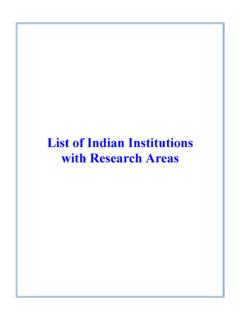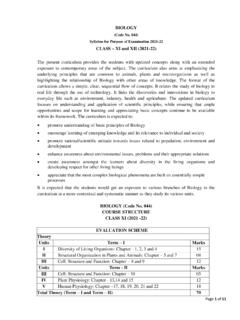Transcription of Augmentative & Alternative Communication
1 Baltimore London SydneyAugmentative & Alternative CommunicationSupporting Children and Adults with Complex Communication NeedsFifth EditionbyDavid R. Beukelman, for Rehabilitation Science and engineering , Madonna Rehabilitation HospitalLincoln, Nebraska andJanice C. Light, Pennsylvania State UniversityUniversity Park, Pennsylvaniawith invited contributorsFOR MORE, go to from Augmentative and Alternative Communication 5e by David R. Beukelman , Janice C. Light vAbout the Online Companion Materials ..xiAbout the Authors ..xiiiAbout the Contributors ..xvPreface ..xixAcknowledgments ..xxiiiSection I People Who Require Augmentative and Alternative Communication .
2 1 Chapter 1 Augmentative and Alternative Communication Processes for Children and Adults with Complex Communication Needs ..3 What Is Augmentative and Alternative Communication ? ..4 Who Relies on Augmentative and Alternative Communication ? ..5 What Is It Like to Rely on Augmentative and Alternative Communication ? ..6 Purposes of Augmentative and Alternative Communication ..9 Augmentative and Alternative Communication Is Only Part of the Answer ..11 Who Supports Those Who Rely on Augmentative and Alternative Communication ? ..12 Preparing for the Future ..14 Overview of Chapters ..15 Chapter 2 AAC 19 Children and Adults Who Require AAC Assessment and Intervention.
3 19 The AAC Team ..20 Phases of AAC Assessment and Intervention ..22 Necessary Conditions for AAC Assessment ..23 The Participation Model ..28 Components of AAC Assessment ..29 ContentsFOR MORE, go to from Augmentative and Alternative Communication 5e by David R. Beukelman , Janice C. Light vi ContentsAssessment of Participation Patterns and Unmet Communication Needs ..31 Assessment of Environmental Supports and Opportunity Barriers ..37 Assessment of the Individual s Capabilities ..41 Adaptations to Assessments ..43 Capability Assessment Domains ..45 Chapter 3 Overview of AAC 91 Principles of AAC Intervention.
4 92 Purpose of AAC Intervention ..96 What Is Communicative Competence? ..97 Planning and Implementing AAC Intervention ..103 Evaluating Intervention ..111 Follow Up ..116 Chapter 4 Collaborating with Family Members and Other Communication Partners ..125 Roles and Responsibilities of Communication Partners ..125 Intervention to Reduce Barriers and Support Participation ..134 Instruction of Communication Partners ..141 Section II Augmentative and Alternative Communication Systems ..157 Chapter 5 Vocabulary Selection and Message Management ..159 Factors that Influence AAC Vocabulary and Message Selection ..160 Messages that Support Interactions ..163 Vocabulary Needs for Different Communication Modes and Contexts.
5 168 Types of Vocabulary ..171 Vocabulary Needs of People with Different Communication Capabilities ..172 Vocabulary Selection Resources and Tools ..177 Vocabulary Maintenance ..180 Chapter 6 Representation, Organization, and Layout of AAC Systems ..185 Multimodal Communication ..185 Representation of Vocabulary Concepts ..187 Unaided 187 Aided AAC ..194 Aided AAC Symbols and Other Representations ..194 Organization and Layout of Aided AAC Systems ..204 Navigation ..222 Encoding and Prediction Techniques ..224 FOR MORE, go to from Augmentative and Alternative Communication 5e by David R. Beukelman , Janice C. Light Contents viiChapter 7 Access Techniques and Output.
6 243 The Selection Set ..245 Access Techniques ..251 Feedback ..260 Message Output and Input ..261 Chapter 8 Selection and Personalization of AAC 269 Process of Selecting and Personalizing AAC ..270 Selection and Personalization of AAC for Adults with Acquired Conditions ..283 Section III Augmentative and Alternative Communication Interventions for Individuals with Developmental Disabilities ..289 Chapter 9 Key Considerations in Augmentative and Alternative Communication Intervention for People with Developmental Disabilities ..291 Cerebral Palsy ..291 Down Syndrome ..298 Intellectual and Developmental Disability ..303 Autism Spectrum Disorder ..306 Childhood Apraxia of Speech.
7 310 Chapter 10 Intervention to Support Communication and Participation of Beginning 321 Principles to Guide AAC Intervention for Beginning Communicators ..321 Ensure Communication Opportunities in the Environment ..325 Stages of Communication Development ..325 Intervention with Individuals Who Are Preintentional ..327 Intervention with Individuals Who Are Intentional but Presymbolic ..333 Intervention with Individuals Who Are Developing Early Symbolic Communication ..342 Intervention with Individuals Who Are Learning to Combine Symbols ..354 Summary of AAC Interventions for Beginning Communicators ..355 Intervention with Individuals with Challenging Behaviors ..356 Chapter 11 Intervention to Build Communicative Competence.
8 375 Language Skills ..376 Operational Skills ..390 Social Skills ..393 Strategic Skills ..407 FOR MORE, go to from Augmentative and Alternative Communication 5e by David R. Beukelman , Janice C. Light viii ContentsCompetence in Digital Communication ..411 Psychosocial Factors that Support Communicative Competence ..412 Chapter 12 Literacy Intervention for Individuals with Complex Communication Needs ..427 With David B. McNaughtonFactors that Affect Literacy Learning ..428 Fostering Emergent Literacy Skills ..432 Teaching Conventional Literacy Skills: Key Components of Intervention ..440 Teaching Basic Conventional Literacy Skills: Learning To Read And Write.
9 448 Teaching Advanced Literacy Skills ..461 Assistive Technologies To Support Literacy ..469 Chapter 13 Intervention to Enhance Participation in Education, Employment, and Community Settings ..483 David B. McNaughtonEducation ..484 Employment and Volunteer Activities ..491 Assisted and Independent Living ..496 Health Care ..498 Community Participation ..502 Skills and Supports for Participation across the Five Domains ..504 Section IV Augmentative and Alternative Communication Interventions for Individuals with Acquired Disabilities ..517 Chapter 14 Individuals with Acquired Physical Conditions ..519 Laura Ball, Amy Nordness, and David Lateral Sclerosis ..520 Multiple Sclerosis.
10 532 Guillain-Barr Syndrome ..536 Parkinson s Disease ..538 Brainstem Stroke ..542 Locked-In Syndrome ..546 Chapter 15 AAC Supports for Adults with Severe Aphasia and/or Apraxia of Speech ..553 Kathryn L. Garrett, Joanne P. Lasker, and Julia King FischerContinuum of AAC Support for Individuals with Aphasia and/or Apraxia of Speech ..555 Emerging AAC Communicators ..556 FOR MORE, go to from Augmentative and Alternative Communication 5e by David R. Beukelman , Janice C. Light Contents ixContextual Choice AAC Communicators.


